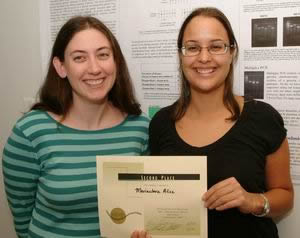Projects including the detection of pathogens in the presence of contaminants and modeling the effect of antibiotics on bacterial populations gained a University of Houston graduate students and professors top honors in the poster competition at the 2005 Keck Center for Interdisciplinary Bioscience Training Annual Research Conference poster competition in October.
The competition attracted over 100 poster submissions from students and faculty from Gulf Coast Consortia member institutions, including Baylor College of Medicine, Rice University, University of Texas Health Science Center-Houston, University of Texas Medical Branch at Galveston and University of Texas M.D. Anderson Cancer Center.
"Two of the top three honors were given to Cullen College of Engineering participants. That’s substantial given the depth of research excellence these institutions represent,” said Richard Willson, professor of chemical engineering and professor of biochemical and biophysical sciences. Willson’s doctoral graduate student, Mariaclara Añez authored the second-place poster, along with fellow UH computer science graduate student, Catherine Putonti. George Fox, professor of biology and biochemistry and professor of chemical engineering, and Yuriy Fofanov, assistant professor of biology and biochemistry, also provided research support for the interdisciplinary project.
The poster titled "Background-Resistant PCR Assays for Dengue Virus Detection" presented the group’s research on a more efficient method for the early detection of dengue virus, an incurable disease transmitted by mosquitoes that prevalent in areas of South and Central America, although several cases have been reported in Texas. Current methods used to detect the virus include antibody-based assays and more recently, hybridization-based assays, which detect the virus by its RNA or DNA. However, these methods of detection can produce false results, resulting in misdiagnoses of the potentially manageable disease. The group’s method of detection includes the introduction of a DNA strand programmed to find its viral counterpart within the patient’s blood while being blind to the vast excess of human DNA and RNA present. Once the strand binds to the viral DNA, the virus can be successfully detected even in the presence of the human DNA.
“The goal of our project is to improve methods of detection,” said Añez. “If we can detect the virus early enough, the symptoms can be treated before they become too severe.”
The third-place poster was co-authored by Michael Nikolaou, associate professor of chemical engineering, and Vincent Tam, assistant professor of clinical sciences. The poster presented the duo’s collaborative research efforts targeted at improving the effectiveness of available antibiotics, while determining better methods for accelerated antibiotic development.
“Bacterial resistance to antibiotics has grown to alarming proportions,” said Nikolaou. “The development of new antibiotics can take decades. We must preserve what antibiotics are available while finding better methods of accelerated production.”
Nikolaou and Tam are working towards modeling the effect of antibiotics on various bacterial populations. Such modeling will allow researchers to design clinically relevant antibiotic dosing regimens that combat emerging bacteria, while possibly reducing the number of necessary clinical trials, which often add many years to the drug development process.
